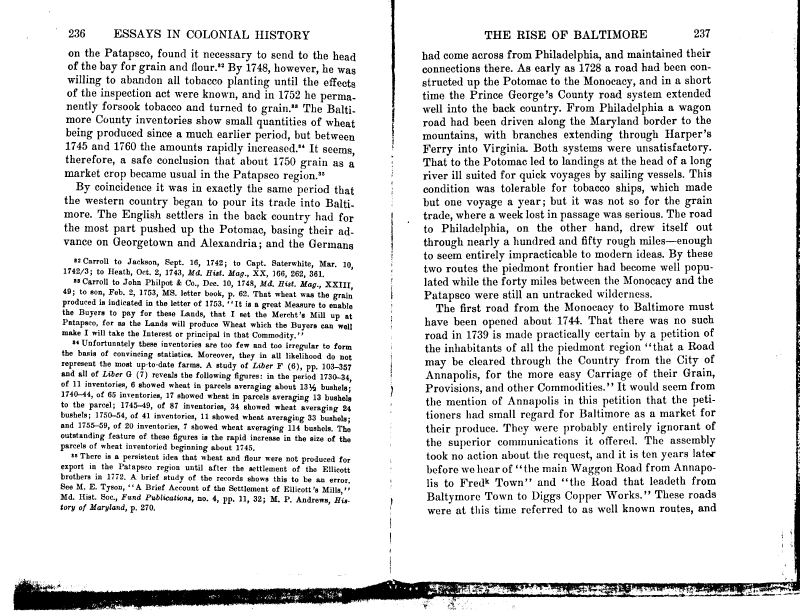|
236
ESSAYS IN COLONIAL HISTORY
on the Patapsco, found it necessary to send to the head
of the bay for grain and flour." By 1748, however, he was
willing to abandon all tobacco planting until the effects
of the inspection act were known, and in 1752 he perma-
nently forsook tobacco and turned to grain." The Balti-
more County inventories show small quantities of wheat
being produced since a much earlier period, but between
1745 and 1760 the amounts rapidly increased." It seems,
therefore, a safe conclusion that about 1750 grain as a
market crop became usual in the Patapsco region.35
By coincidence it was in exactly the same period that
the western country began to pour its trade into Balti-
more. The English settlers in the back country had for
the most part pushed up the Potomac, basing their ad-
vance on Georgetown and Alexandria; and the Germans
«2 Carroll to Jackson, Sept. 16, 1742; to Capt. Saterwhite, Mar. 10,
1742/3; to Heath, Oct. 2, 1743, Md. Hist. Mag., XX, 166, 262, 361.
»» Carroll to John Philpot & Co., Dee. 10, 1748, Md. Hist. Mag., XXIII,
49; to son, Feb. 2, 1753, MS. letter book, p. 62. That wheat was the grain
produced is indicated in the letter of 1753. "It is a great Measure to enable
the Buyers to pay for these Lands, that I set the Mercht's Mill up at
Patapseo, for as the Lands will produce Wheat which the Buyers can well
make I will take the Interest or principal in that Commodity."
« Unfortunately these inventories are too few and too irregular to form
the basis of convincing statistics. Moreover, they in all likelihood do not
represent the most up-to-date farms. A study of Liber F (6), pp. 103-357
and all of Liber G (7) reveals the following figures: in the period 1730-34,
of 11 inventories, 6 showed wheat in parcels averaging about 13% bushels;
1740-44, of 65 inventories, 17 showed wheat in parcels averaging 13 bushels
to the parcel; 1745-49, of 87 inventories, 34 showed wheat averaging 24
bushels; 1750-54, of 41 inventories, 11 showed wheat averaging 33 bushels;
and 1755-59, of 20 inventories, 7 showed wheat averaging 114 bushels. The
outstanding feature of these figures is the rapid increase in the size of the
parcels of wheat inventoried beginning about 1745.
»<> There is a persistent idea that wheat and flour were not produced for
export in the Patapsco region until after the settlement of the Ellicott
brothers in 1772. A brief study of the records shows this to be an error.
See M. E. Tyson, '' A Brief Account of the Settlement of Ellicott's Mills,''
Md. Hist. Soc., Fund Publications, no. 4, pp. 11, 32; M. P. Andrews, His-
tory of Maryland, p. 270.
THE RISE OF BALTIMORE
237
had come across from Philadelphia, and maintained their
connections there. As early as 1728 a road had been con-
structed up the Potomac to the Monocacy, and in a short
time the Prince George's County road system extended
well into the back country. From Philadelphia a wagon
road had been driven along the Maryland border to the
mountains, with branches extending through Harper's
Ferry into Virginia. Both systems were unsatisfactory.
That to the Potomac led to landings at the head of a long
river ill suited for quick voyages by sailing vessels. This
condition was tolerable for tobacco ships, which made
but one voyage a year; but it was not so for the grain
trade, where a week lost in passage was serious. The road
to Philadelphia, on the other hand, drew itself out
through nearly a hundred and fifty rough miles—enough
to seem entirely impracticable to modern ideas. By these
two routes the piedmont frontier had become well popu-
lated while the forty miles between the Monocacy and the
Patapsco were still an untracked wilderness.
The first road from the Monocacy to Baltimore must
have been opened about 1744. That there was no such
road in 1739 is made practically certain by a petition of
the inhabitants of all the piedmont region "that a Road
may be cleared through the Country from the City of
Annapolis, for the more easy Carriage of their Grain,
Provisions, and other Commodities." It would seem from
the mention of Annapolis in this petition that the peti-
tioners had small regard for Baltimore as a market for
their produce. They were probably entirely ignorant of
the superior communications it offered. The assembly
took no action about the request, and it is ten years later
before we hear of '' the main Waggon Road from Annapo-
lis to Fredk Town" and "the Road that leadeth from
Baltymore Town to Diggs Copper Works." These roads
were at this time referred to as well known routes, and
"»23
|

